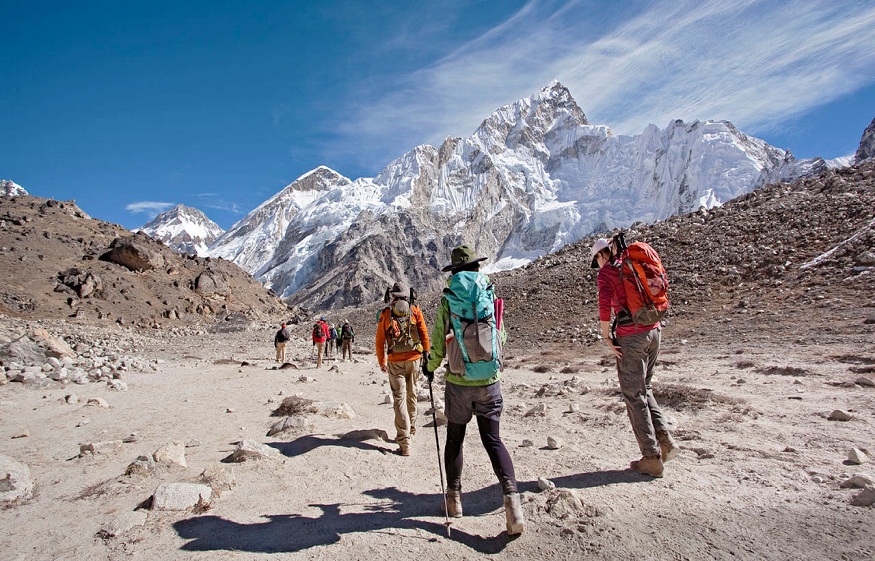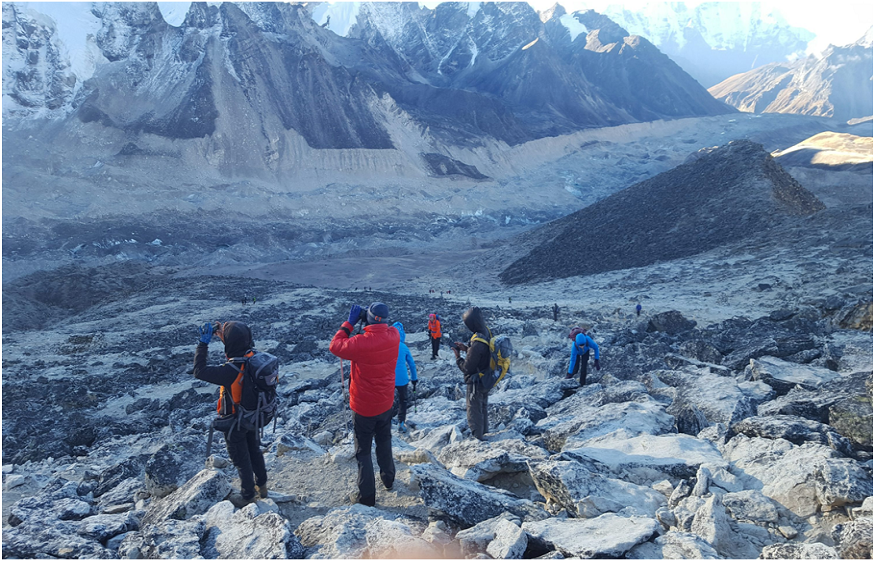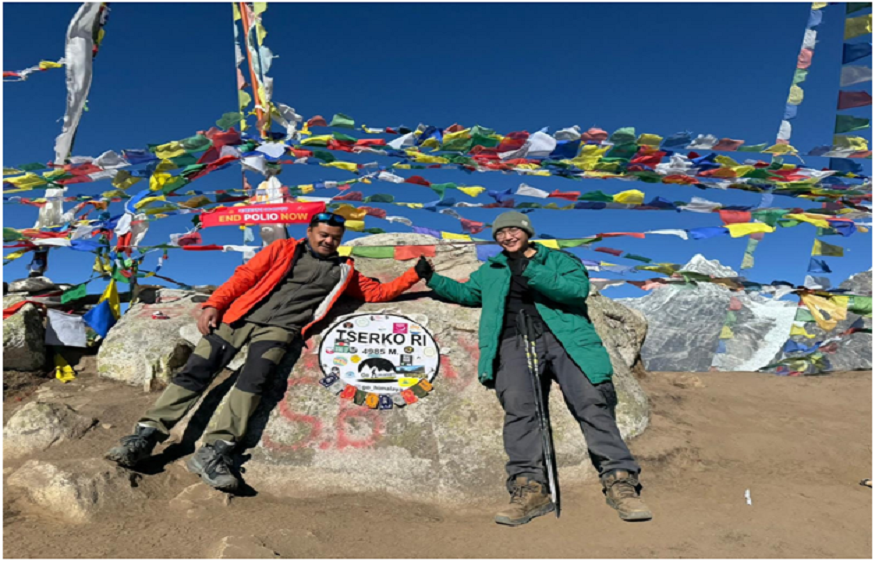The post Photography gear for Everest Base Camp (EBC) trek with a guide appeared first on Himalayan Glacier Trekking. With picturesque landscapes, soaring peaks, and walking one of the most famous trekking trails in the world, a portable camera can make capturing those memories so much easier. Whether you are a passionate picture lover or just want to capture the experience to keep a few shots, the best camera for the EBC trek is a well-thought-out selection.
When picking a camera for the Everest Base Camp trek, one of the main considerations is portability. Since the trek can last 12 days or longer, lugging heavy equipment can be unwieldy. So lightweight options that keep image quality are perfect. Mirrorless cameras, however, have become increasingly popular with photographers. Being compact and versatile, they can range from basic to professional quality pictures in a lightweight package. An interchangeable lens camera, such as the Sony Alpha 7C or the Fujifilm X-T4, will give you great image quality in a portable package and the ability to swap out lenses for different kinds of shots. Great for trekking, where every ounce counts, but you want to make sharp, detailed images of the Himalayan landscape.
For simpler, easier-to-set-up devices, compact cameras are also great. Both Canon G7X Mark III & Sony RX100 VII are compact, lightweight weight and also manage to have excellent image quality. These cameras are good for trekkers looking for a camera that still fits conveniently in the pocket or daypack and does not sacrifice photo quality. Both models also offer fast autofocus, image stabilization, and can shoot in 4K video, so smooth video footage of your hike can be captured while you don’t have to bring another camera or part to film.
For adventure photography, or something a little bit more rugged, you should consider getting an action camera like the GoPro Hero 11 or the DJI Osmo Action. They are able to survive the rigors of a trek in the rugged and unpredictable world of the Everest region as they are built to be tough, waterproof, and rugged. With their wide-angle lenses and ultra-high-definition video recording capabilities, action cameras are ideal for capturing fast-paced scenes or strapping to your backpack or helmet for hands-free filming while trekking. They’re also an excellent companion for occasions when you’re fording rivers or hiking in the rain.
Battery life. Another crucial factor when deciding which camera to use for the EBC is battery life. With long days and not much access to charging points when trekking to Everest Base Camp, a camera with good battery life is essential. Because of this, mirrorless cameras and DSLRs are notoriously “battery hogs” — so it might be worth picking up some more batteries. Specific compact cameras, such as the Canon PowerShot SX740 HS, have excellent battery life and are a lot more energy-efficient. Also, packing a portable power bank or solar charger can help you recharge your camera’s batteries on the fly, especially in locations where access to electricity may be scarce or spotty.
Camera equipment can also be tested in the Everest region’s weather conditions. High altitudes and frigid temperatures can impact your camera’s performance. It’s important to select a camera that functions well in colder temperatures, and to store it warm place when not in use. A good weather-sealed camera provides protection against the elements, but that won’t be any use if the equipment isn’t kept safe from dust, moisture, and cold. Weather-sealing, such as that found on cameras like the Olympus OM-D E-M5 Mark III and the Sony Alpha 7R IV, allows you to shoot in tough conditions without worrying about damage.
For landscape photography trekkers who want the highest possible image quality, a DSLR such as the Canon EOS 5D Mark IV or the Nikon D850 offers superb dynamic range, detail, and low-light performance. These cameras are a bit heavy compared to mirrorless or compact options; however, they capture amazing quality images, which is a major plus, especially when able to capture the broad, sweeping vistas and the high-resolution shots of the landscape and snow-capped peaks of the Everest region.
Trek To Base Camp Mount Everest Ultimately, the best camera for the Everest Base Camp trek is one that fits your priorities: Portability, ease of use, ruggedness, or image quality. A mirrorless camera, compact, or a DSLR all have advantages based on the shots you are looking for. Consider the high altitude, weather conditions, and the limited availability of charging stations and tabs, and make sure that you are carrying some extra batteries or power sources. Equipped with the proper gear, you will be prepared to capture the beauty of one of the world’s most majestic trekking locales.
Introduction: Why You Need a Good Camera on the EBC Trek
One of the most famous as well as magnificent trekking destinations in Nepal is the Everest Base Camp (EBC). Running over uneven ground and affording staggering views of vertical ridges, glaciers, and distant hamlets, it’s critical to capture the spirit of this route with a quality camera. A camera helps trekkers capture memories of the breathtaking landscapes, colorful local culture, and personal achievements throughout the journey. Whether you are an avid photographer or are a casual adventurer looking to document your trip, having the right camera ensures you are able to capture your journey through the Himalayas forever. Whether you are photographing sweeping views from the peak of Mount Everest or the day-to-day life of Sherpas and other trekkers, a camera can help you remember the adventure long after the trek has concluded. Due to the difficult terrain and unpredictable weather, it’s essential to select a camera that can handle the rigors of the EBC trek while also providing high-quality images. Let us introduce you to the most important things to keep in mind when choosing the right camera for your Everest Base Camp trip.
Choosing a Camera for the EBC Trek: Factors to Consider
When deciding on what is the best camera to take on the Everest Base Camp trek, you will want to consider your gear carefully to ensure you do not miss your best moments whilst not carrying too much bulky gear. One of the first considerations is portability — the trek is physically demanding and will last several days, so you’ll want to choose a lightweight device that won’t weigh down your backpack unnecessarily. Additionally, durability is key; the ruthless conditions of the Himalayas, such as cold, dust, and moisture, require handling equipment. Battery life is another major consideration. You’ll have limited access to charging points along the trail here, so you need to select a camera with long battery life or plan to carry extra batteries. Another thing to look out for is picture quality, especially when photographing the vast landscapes of Everest. Clear pictures with good color reproduction are crucial for capturing the beauty of the region in its full glory, so a wise investment in decent cameras will help you create some beautiful memories. Finally, consider what type of photography you’ll be doing — whether sweeping landscape shots, portraits of locals, or action-packed moments, the right camera should support your needs and style. When you balance these things, you will find the camera you are looking pass to match your needs, and with a camera, you will surely capture more memorable moments on trekking.
Best Mirrorless Camera: For Beautiful Landscape Photography
Everest Base Camp Trek Mirrorless cameras (eg, Micro Four Thirds, APS-C) are now popular with trekkers because they take up very little space, but still offer great image quality. They provide the advantages of interchangeable lenses, advanced autofocus capabilities, and exceptional image quality, making them a popular option for visitors looking to shoot stunning landscape images on the Everest Base Camp trek. One of our favourite options is the Sony Alpha 7C, this instant classic compact, full-frame mirrorless camera is light to carry yet produces incredible quality for photographs, particularly when capturing landscapes. It weighs so little that it can easily fit in your bag or be carried around for days while you hike through the mountains, and its high-resolution sensor and superb performance in the low light mean you’ll do justice to the north in every photo wherever you go. If you’re looking for something with a retro design, the Fujifilm X-T4 is also very popular, with exceptional image quality and a rugged body. With 4K video capabilities and fast autofocus, it is perfect for both photos and video of the stunning landscapes. Things like this mirrorless camera are wonderful for trekkers who want high-quality photos but a kit that will not slow them down on the grueling trek to Everest Base Camp.
DSLR Cameras are a great option for trekkers who want the best quality images. DSLRs are known for their excellent image quality and better sensor size, great for landscape, portrait, and low-light photography. For professional photographers looking for an excellent image, a rugged build, and a full-frame sensor, the Canon EOS 5D Mark IV is a go-to model. With a high enough resolution to be able to pull off beautiful detail in any brightly-lit scene and in low-light as well, it is well-suited to capture the stunning vistas of Everest. The Nikon D850 is also an excellent choice with fantastic image sharpness, amazing dynamic range, and speedy autofocus. It is particularly well-compensated for high-contrast field scenes, such as the extensive, snow-covered peaks of the Himalayas. Although DSLRs are generally on the heavier side in comparison to mirrorless cameras, the quality they deliver in terms of high-resolution images with great color depth and detail makes them a popular choice among serious photographers. These cameras are made to withstand the harsh elements encountered on high-altitude treks, but trekkers should be aware of the extra weight they’ll be carrying for long hours on the trail.
There are compact point-and-shoot cameras, which are really just small, lightweight cameras that can be carried around easily.
Everest Base Camp Treks If you value portability and convenience without sacrificing image quality, a compact point-and-shoot camera is a fantastic option for the Everest Base Camp trek. These cameras are small, light, and simple to use, making them perfect for those who don’t want to bother with the complexity of interchangeable lenses or clunky hardware. The best of the bunch is the Canon PowerShot G7X Mark III with its 4K video, fast autofocus, and 20.1-megapixel sensor. With a small design, it should fit right into your pocket or daypack and give you a camera that can take photos at a moment’s notice without weighing you down. Another great compact camera is the Sony RX100 VII, which offers impressive image quality, a sleek design, and quick performance. Its 24-200mm zoom lens gives you the flexibility to capture anything from a sweeping landscape to an up-close look at local life. These cameras are a great option for trekkers who want a low-maintenance way to document their trek and keep it light and tight in their pack.
Action cameras: Perfecting the moment in the extreme
If you’re a trekker looking for a rugged, multipurpose camera to capture your memorable moments on the Everest Base Camp trek, then an action camera is a great way to go. Implored to endure the harshest elements, including ice, grime, and dampness, action cameras are the ideal device for documenting the raw energy of the trek. The GoPro HERO11 Black is also one of the best action cameras out there, ready for knocking around, shooting 4K video, and thanks to HyperSmooth, it can give you blur-free shots of your hike even in the roughest conditions. It can be affixed to your backpack, helmet, or chest in order to capture hands-free shots as you run through rugged terrain. Another solid option is the DJI Osmo Action, which has a dual-screen design so you can look at yourself while you’re filming video or selfies, and it’s waterproof and shockproof, too. Action cameras come in handy to get those moving snaps when you have to cross the river, run up some steep path, or get a time-lapse of the Rocky Mountains. They’re unbelievably rugged, they’re versatile, and they’re built to withstand the physical demands of high-altitude trekking. If you want an adventure-style documentary of your trek, an action camera is an ideal tool for the job.
Cameras: Low-Light Performance; Sunrise/Sunset Performance
They’re also great for low-light photography, where you or your subject needs to remain still, such as with the picturesque lighting you’ll experience at Everest Base Camp during sunrise and sunset — perfect for photographers, but you’ll need a camera that does well in low-light conditions to capture the moment as best you can. For nighttime conditions, a camera with a big sensor and a good high ISO is essential. Best for low light: Sony Alpha 7R IV full-frame mirrorless camera. Its 61-megapixel sensor excels in fine detail, even in low light, and is perfect for the soft light of early mornings or evenings. Trekkers scouting for versatility and portability will find the Fujifilm X-T4 to be superlative for low-light situations, too, returning clean images with little noise at higher ISO ratings. This camera can also do the sunrise and sunset thing, terrific with color richness and contrast. Perfect for handheld shooting in low-light conditions, the Canon EOS R6 features a full-frame sensor with excellent high-ISO performance, as well as in-body stabilization. And wide aperture lenses (f/2.8 or lower allow cameras to collect more light, making it possible to get those breathtaking photos when the sun drops behind the Himalayas or arises over puffy ridge-covered snow peaks.
Robustness and Weather Resistance: Cameras That Are Built to Last
Mount Everest base camp Trek When it comes to mountaineering, extreme weather exposure is an unavoidable challenge during the trek to Everest Base Camp, including cold, wind, dust, and rain, which makes weather-sealed cameras essential. A weatherproof camera is made to survive the extreme elements of the Himalayas, prolonging the life of your gear during the trek. It’s a tough little body , too, rain, snow, and dust resistant, much like the Olympus OM-D E-M1 Mark III. The Canon EOS 5D Mark IV, likewise, is sturdy and built with weather resistance in mind, making it ideal for photographing the desolate landscape no matter the rain, snow, or shine. Delivering a range of powerful functions, solid, weather-sealed sturdiness, but as a simple upgrade to take on cold and rain while actually delivering a quality image, the Fujifilm X-T3 is an ideal option for trekkers who do not want to weigh themselves down. Action cameras such as the GoPro HERO11 Black are built to withstand extreme environments, including shock resistance and waterproofing, to record those wild moments on the go, even if it rains or during river crossings. Himalaya weather is unpredictable, so while deciding camera for the EBC trek, you have to consider weather sealing and a strong build to be sure that even your gear can endure the weather.
Dedicated vs Digital Cameras: Which Camera to Choose For EBC?
With smartphone technology improving every day, perhaps you could survive the trek to Everest Base Camp with just your camera phone? Even premium smartphones such as the iPhone 14 Pro or the Samsung Galaxy S23 Ultra have downright awesome camera systems, which, thanks to all the computational photography hype these days, are incredibly easy to use. They are small, light, and always at the ready, so you can take quick snapshots and video clips while on the trail. One significant downside is that smartphones typically do not have the manual controls and image quality found on dedicated cameras, especially in low-light conditions and when zooming in. Smartphones are great for everyday photos, but mirrorless and DSLRs give you more flexibility in settings, image quality, and lens type, depending on what you want to shoot. A DSLR or mirrorless can give you better resolution, better low-light performance, and more dynamic range, especially for landscape shots. Dedicated cameras are often larger and heavier, which can make for cumbersome trekking. Your decision really comes down to what matters most to you: If you want the best image quality possible, and don’t mind carrying extra pounds around, then the dedicated camera wins. But if portability and convenience matter most to you, a smartphone may suffice for your EBC trek.
Accessories You’ll Need: Lenses, batteries, and other bits
Everest Base Camps Choosing equipment is crucial, but once you have selected your camera, you need to consider which accessories will be indispensable to making the most of your gear on the Everest Base Camp trek. The lenses you have will make a big difference in the kinds of shots you will be able to get. If you plan to engage in landscape photography, a wide-angle lens (e.g., 16-35mm) is perfect for sweeping images of the Himalayan peaks, whilst a telephoto (e.g.,70-200mm) lens comes in handy for shots of far away mountains or the details of wildlife. You will want extra batteries; the cold can sap your battery life in a hurry. I recommend bringing at least three extra batteries because opportunities to charge them on the trek are few and far between. A battery grip also helps provide long battery life. Bring a portable charger or a solar-powered charger; you can charge up at rest stops or lodges. Another essential accessory is memory cards; be sure you have multiple high-capacity SD cards on hand so that you don’t run out of storage space during the trek. An accompanying camera bag would also protect your gear from dust, rain, and accidental bumps in one of the world’s harshest terrains. A tripod can help with long exposure shots, especially at sunrise or sunset, but it does add weight to your pack.
Camera Storage and Backup Options on the Trail
Himalayan Base Camp Trek When trekking to Everest Base Camp, keeping your camera gear safe and quickly accessible is very important. You’ll never have to lose a beloved photo again because of technical problems with a good storage and backup solution. Be it a padded camera bag or a dry bag for your camera storage, ensure that the camera bag can protect against moisture, dust , as well as physical impact. You want these bags to fit comfortably within your trekking bag, but also in a manner that allows for quick access during shots on the trail. If you can, take a portable external hard drive with you, or do your best to back up photos via cloud storage. Portable hard drives offer the potential for large amounts of data storage. Just remember to keep your backup in a waterproof case to protect it from the elements. If you intend to do cloud storage, make sure you will have Wi-Fi at the lodges along the trail or you can visit internet cafes in the local area to upload your photos. Regularly back up your images to safeguard against the potential loss of cherished memories. If you’re hiking in remote places, bring the right charging devices, including solar chargers or power banks, to ensure your storage devices remain charged.
Final thoughts on the best camera for trekking to EBC
Everest Base Camp trek cost The choice of which camera is best for your Everest Base Camp trek will ultimately come down to your personal preferences, your intent while photographing the experience, and the style of experience you want. So, whether you’re looking for something portable, with great image quality, or the most rugged body, there’s a camera out there for you. The best image quality and versatility are found in mirrorless or DSLR cameras, which makes them ideal for trekkers who want to capture the finer details of gorgeous landscapes. But if you want convenience and to travel light, compact point-and-shoot cameras or smartphones can still yield great results. Keep in mind other aspects like weatherproofing, accessories, and storage space to make your camera arrangement suitable for high-altitude trekking. If you are able to bring the right gear, you’ll be able to capture the incredible beauty of the Everest region, which will leave lasting memories for years to come.Don’t hesitate to get in touch! Reach us at info@sherpaexpeditiontrekking.com or on WhatsApp +977 9866007038 for all your travel needs.



